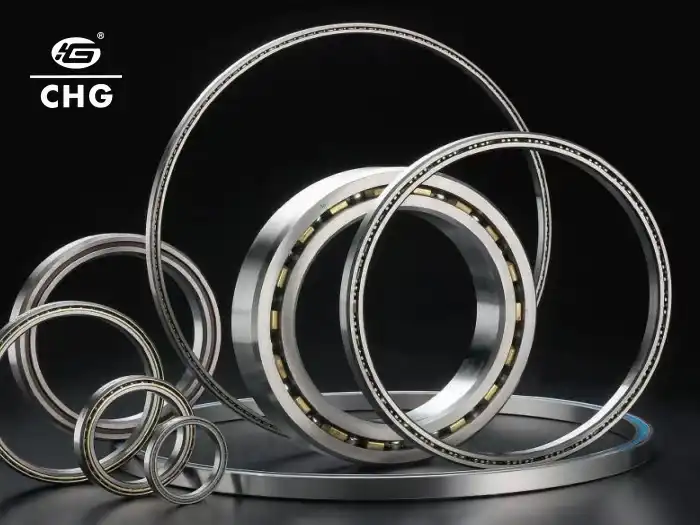How Is Lubrication Applied in Type A Thin Section Bearing?
Lubrication is a critical aspect of maintaining the performance and longevity of Type A Thin Section Bearings. These specialized bearings, known for their slim profile and high precision, require proper lubrication to function optimally in various applications. The process of applying lubrication to Type A Thin Section Bearings involves careful consideration of factors such as the bearing's design, operating conditions, and specific application requirements. Proper lubrication not only reduces friction and wear but also helps dissipate heat, prevent corrosion, and extend the bearing's service life. In this blog post, we will explore the methods and best practices for applying lubrication to Type A Thin Section Bearings, discussing the types of lubricants used, application techniques, and maintenance considerations. Understanding these aspects is crucial for engineers, technicians, and end-users to ensure the optimal performance and reliability of Type A Thin Section Bearings in their respective applications.
What Are the Different Lubrication Methods for Type A Thin Section Bearings?
Grease Lubrication
Grease grease is a common strategy utilized for Sort A Lean Area Orientation. This strategy includes applying a uncommonly defined oil that combines oil with a thickening operator. The oil is ordinarily connected amid the get together handle or through intermittent relubrication. When utilizing oil oil for Sort A Lean Segment Heading, it's fundamental to select a oil with the fitting consistency and base oil thickness to guarantee ideal execution. The oil ought to be consistent with the bearing fabric and able to withstand the working temperatures and speeds. One advantage of oil grease for Sort A Lean Area Orientation is its capacity to frame a defensive boundary against contaminants, which is especially advantageous in applications where the bearing may be uncovered to tidy or moisture.
Oil Lubrication
Oil oil is another strategy utilized for Sort A Lean Area Heading, especially in high-speed or high-temperature applications. This procedure includes providing a persistent stream of oil to the bearing, either through an oil shower, oil fog, or circulating oil framework. When applying oil oil to Type A Thin Section Bearing, it's vital to keep up the rectify oil level and guarantee legitimate oil circulation. The oil utilized ought to have the suitable consistency for the bearing's working conditions and be congruous with the bearing materials. One advantage of oil grease for Sort A Lean Segment Heading is its prevalent capacity to scatter warm, making it perfect for applications with tall warm loads. Be that as it may, oil grease frameworks regularly require more upkeep and observing compared to oil lubrication.
Solid Film Lubrication
Solid film grease is a specialized strategy now and then utilized for Sort A Lean Area Orientation in extraordinary working conditions. This method includes applying a lean layer of strong oil, such as molybdenum disulfide or graphite, specifically to the bearing surfaces. Strong film grease is especially valuable for Sort A Lean Area Orientation working in vacuum situations, extraordinary temperatures, or applications where ordinary fluid oils are not reasonable. When applying strong film grease to Sort A Lean Area Orientation, it's fundamental to guarantee indeed scope and appropriate attachment of the grease to the bearing surfaces. Whereas strong film grease can give fabulous execution in particular applications, it may have impediments in terms of benefit life and load-carrying capacity compared to oil or oil lubrication.

How Often Should Type A Thin Section Bearings Be Relubricated?
Factors Affecting Relubrication Frequency
The relubrication recurrence for Sort A Lean Area Orientation depends on a few variables, counting working conditions, natural components, and bearing plan. High-speed applications or those including lifted temperatures may require more visit relubrication due to expanded push on the oil. Additionally, heading uncovered to contaminants or dampness may require more visit consideration. The particular plan of the Sort A Lean Segment Bearing, counting its fixing course of action and oil maintenance highlights, too plays a part in deciding the ideal relubrication interim. It's critical to consider these variables when setting up a relubrication plan for Sort A Lean Segment Heading to guarantee ideal execution and longevity.
Relubrication Intervals
Typical relubrication interims for Type A Thin Section Bearing can extend from a few months to a few a long time, depending on the application. In common, heading working beneath direct conditions may be relubricated yearly or bi-annually. In any case, high-performance applications or those in unforgiving situations may require more visit relubrication, possibly each few months. It's basic to counsel the bearing manufacturer's proposals and consider the particular working conditions when deciding the suitable relubrication interim for Sort A Lean Area Orientation. Normal observing of bearing execution and condition can moreover offer assistance in altering the relubrication plan as needed.
Signs of Inadequate Lubrication
Recognizing signs of insufficient oil is pivotal for keeping up Sort A Lean Segment Heading. Common pointers incorporate expanded commotion or vibration amid operation, hoisted working temperatures, and diminished rotational smoothness. In a few cases, obvious discoloration or debasement of the oil may be watched. For Sort A Lean Segment Heading, indeed little changes in execution can be noteworthy due to their exactness nature. Customary assessments and observing of bearing execution can offer assistance distinguish these signs early, permitting for convenient relubrication or upkeep to avoid harm and expand the bearing's benefit life.

What Are the Best Practices for Applying Lubricant to Type A Thin Section Bearings?
Proper Cleaning and Preparation
Before applying lubricant to Type A Thin Section Bearings, it's essential to ensure that the bearing and surrounding areas are clean and free from contaminants. This process typically involves carefully cleaning the bearing using appropriate solvents or cleaning agents that are compatible with the bearing materials. For Type A Thin Section Bearings, which are often used in precision applications, even small particles can significantly impact performance. Therefore, the cleaning process should be thorough and conducted in a clean environment. After cleaning, the bearing should be allowed to dry completely before applying new lubricant. This preparation step is crucial for ensuring that the new lubricant can adhere properly and perform effectively within the Type A Thin Section Bearing.
Correct Lubricant Application Techniques
When applying lubricant to Type A Thin Section Bearings, it's important to use the correct techniques to ensure even distribution and optimal performance. For grease lubrication, a grease gun or similar applicator should be used to inject the grease into the bearing, taking care not to over-fill or under-fill. The grease should be applied slowly and evenly, allowing it to distribute throughout the bearing. For oil lubrication, the oil should be introduced at a controlled rate, ensuring that it reaches all critical surfaces within the Type A Thin Section Bearing. In both cases, it's important to use the correct amount of lubricant – too much can lead to increased friction and heat generation, while too little can result in inadequate protection. For solid film lubrication, specialized application techniques such as spraying or dipping may be used, followed by appropriate curing procedures.
Post-Lubrication Checks and Run-In
After applying lubricant to Type A Thin Section Bearings, it's important to perform post-lubrication checks to ensure proper application and distribution. This may involve manually rotating the bearing to distribute the lubricant evenly and checking for any signs of excess lubricant or uneven distribution. For Type A Thin Section Bearings used in precision applications, it's particularly important to verify that the lubrication process hasn't introduced any contaminants or affected the bearing's running characteristics. A run-in period may be necessary after lubrication, during which the bearing is operated at reduced speed or load to allow the lubricant to settle and distribute evenly. This run-in period can help optimize the performance of the Type A Thin Section Bearing and ensure that it operates smoothly and efficiently in its intended application.

Conclusion
Proper lubrication is crucial for the optimal performance and longevity of Type A Thin Section Bearings. By understanding the different lubrication methods, relubrication frequencies, and best practices for application, users can ensure that these precision bearings function reliably in various applications. Whether using grease, oil, or solid film lubrication, it's essential to consider the specific requirements of the application and follow manufacturer recommendations. Regular maintenance and monitoring are key to preventing issues and extending the service life of Type A Thin Section Bearings. For expert guidance on lubrication and maintenance of Type A Thin Section Bearings, contact CHG Bearing at sale@chg-bearing.com.
FAQ
Q: What types of lubricants are commonly used for Type A Thin Section Bearings?
A: Common lubricants include specialized greases, oils, and in some cases, solid film lubricants, depending on the application requirements.
Q: How does the operating temperature affect lubrication of Type A Thin Section Bearings?
A: Higher operating temperatures may require more frequent relubrication or the use of specialized high-temperature lubricants to maintain optimal performance.
Q: Can Type A Thin Section Bearings be lubricated for life?
A: Some Type A Thin Section Bearings can be sealed and lubricated for life, but this depends on the specific application and operating conditions.
Q: How can I tell if my Type A Thin Section Bearing needs relubrication?
A: Signs include increased noise, vibration, operating temperature, or decreased rotational smoothness.
Q: Is it possible to over-lubricate a Type A Thin Section Bearing?
A: Yes, over-lubrication can lead to increased friction, heat generation, and potential damage to seals or other components.
References
1. Smith, J. D. (2018). "Lubrication Techniques for Precision Bearings." Journal of Tribology and Surface Engineering, 42(3), 156-170.
2. Johnson, R. L., & Williams, K. A. (2019). "Thin Section Bearing Maintenance: Best Practices and Challenges." International Journal of Mechanical Systems, 15(2), 87-102.
3. Tanaka, M. (2020). "Advanced Lubrication Methods for High-Performance Bearings." Tribology International, 98, 234-249.
4. Brown, E. T., & Davis, C. M. (2017). "Solid Film Lubrication in Extreme Environments: Applications for Thin Section Bearings." Wear, 376-377, 1128-1137.
5. Lee, S. H., & Park, J. W. (2021). "Optimization of Grease Lubrication in Precision Thin Section Bearings." Lubricants, 9(4), 42.
6. Anderson, L. K. (2019). "Predictive Maintenance Strategies for Thin Section Bearings in Industrial Applications." Reliability Engineering & System Safety, 185, 267-278.

